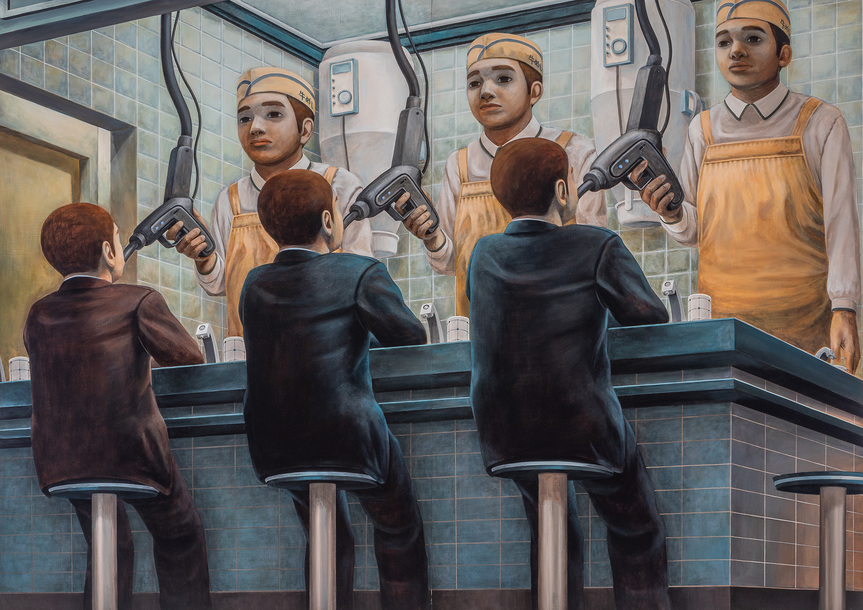-
From Current Issue
-
- Editor’s Letter Fire in the Heart
- Reviews I Gusti Ayu Kadek Murniasih
- Reviews 11th Seoul Mediacity Biennale: “One Escape at a Time”
- Dispatch Networked China
- One on One Monira Al Qadiri on Yukio Mishima
- Essays The rise of independent art spaces in pandemic-era Shanghai
- Features Tuan Andrew Nguyen
- Table of Contents
- Web Exclusives
- Archive
- Subscribe

R
E
V N
E
X
T
Installation view of TETSUYA ISHIDA’s “Self-Portrait of Other,” at Wrightwood 659, Chicago, 2019. All photos by Michael Tropea Photography; copyright the artist; courtesy Wrightwood 659, Chicago, unless otherwise stated.
In the wake of World War II, artists such as Gerhard Richter and Georg Baselitz evoked the lasting psychological trauma of such utter devastations in figurative paintings. Yet the potential of painting to grapple with the psychopathology of late capitalism has remained somewhat unexplored, for the widely commodified medium was deemed inept at examining the totalizing forces of economic transformations. Such critique was therefore reserved for what John Chandler and Lucy Lippard referred to as “dematerialized” practices, such as video or performance art, which could not be so easily circulated on the art market. As such, figurative paintings were fixated on depictions of fantasy and desire in the years leading up to the new millennium, as in the oversexualized, absurdist canvases of John Currin and the translucent, endearing portraits of film stars by Elizabeth Peyton. The sleek, eerie paintings by the late Tetsuya Ishida address the lacuna outside of such established narratives within the Euro-American tradition, by exploiting the capacity of figuration to capture the malaise experienced by the Japanese during the “Lost Decade”—a prolonged period of economic stagnation in the 1990s during which the country’s real-estate prices plummeted and unemployment rates soared. “Self-Portrait of Other,”the artist’s first retrospective outside his homeland, supplied a succinct overview of the artist’s practice.
The diaristic nature of the paintings was unmistakable throughout the exhibition. One canvas after another, Ishida introduces male figures donning dark gray suits and school uniforms, recalling images of Japanese businessmen and schoolboys rife in popular culture. Expectations of conformity and productivity in various disciplinary situations, such as schools and offices, are brought into sharp relief through human figures with machinic limbs. In Refuel Meal (1996), suited employees are force-fed through metal tubes, whereas Recalled (1998) depicts a white-uniformed worker packing a disassembled man within a Styrofoam box as sullen figures—his family, perhaps—look on. Slight hopes of escape are quickly dissolved: the airplane tied to the human figure attempting flight is at a standstill in Person Who Can No Longer Fly (1996), and the prospect of a serene stroll while On Holiday (1999) is disturbed by a decapitated head on a stroller being walked by a toddler. That the artist died allegedly by suicide at the age of 32 casts these morose, listless figures as components of an unsettling self-portrait. The distorted figures that populate his journals, displayed at the beginning of the exhibition, suggest that the artist and his imagined subjects are part and parcel of each other.
At times, the narrative charge of the paintings undercuts their own evocative potential by literalizing the experience of psychological pain. There is little to construe in Cargo (1997), for instance, where suited men are wrapped in the form of boxes, or in Supermarket (1996), in which the arms of a shopper are transformed into conveyer belts, since the dystopian depictions of contemporary Japan register clearly. Far more riveting, therefore, are the Kafkaesque deformations of the human body into a lobster (Gripe, 1996), a cockroach (Restless Dream, 1996), and a railroad (Search, 2001), as well as insertions of opaque, pitch-black space into human faces that introduce uncharted territories (Return Journey, 2003). The driving plots are not instantly discernible in these paintings, complicating their status as representations of disquieting, imaginary concoctions. The paintings instead propose that the psychological traumas shaped by the inescapable currents of late capitalism cannot be easily reduced to a singular image with a contained narrative. In Ishida’s deft painterly gestures, we glimpse a delicate and perceptive mind, whose imaginative power supplied him both artistic fuel and unfiltered pain.
Tetsuya Ishida’s “Self-Portrait of Other” is on view at Wrightwood 659, Chicago, until December 14, 2019.
To read more of ArtAsiaPacific’s articles, visit our Digital Library.
















